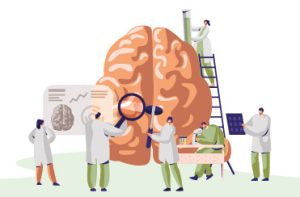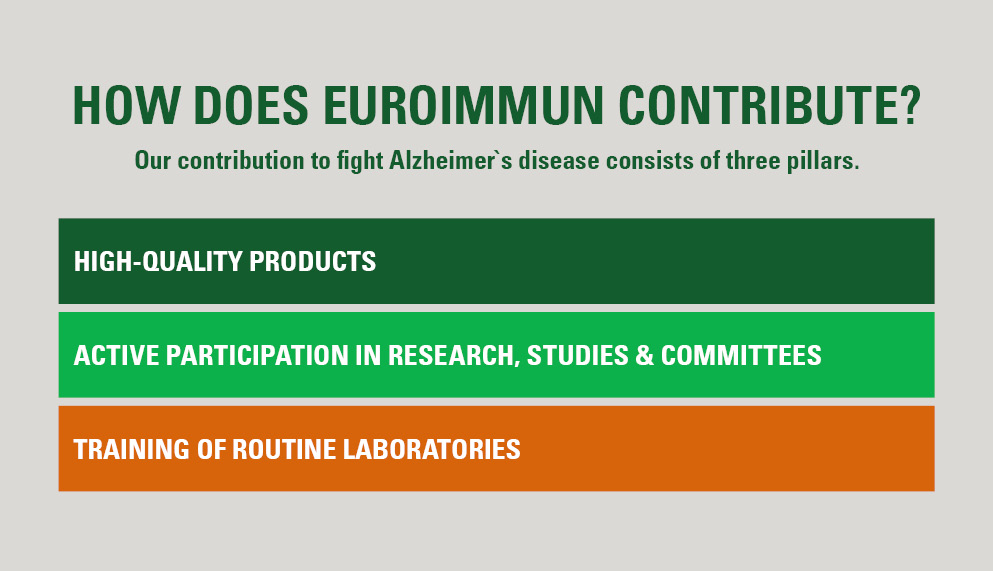Britta Brix has been working for EUROIMMUN since 2012 and has been head of the department of Neurodegenerative Diseases Diagnostics since 2013, focussing on Alzheimer’s. In our interview she tells why she is interested in this subject and how she, as employee of EUROIMMUN, contributes to improved diagnostics of this severe disease.
How did you come to the field of Alzheimer’s diagnostics and your task within the company?
I always found it fascinating that our thoughts and being are defined by molecular processes in the brain. Thus, I already dealt with the topic of neurology during my doctoral studies. And this was the reason why EUROIMMUN first employed me in neuroimmunological research when I started to work here. However, that was only for a short period because someone was needed to manage the newly started project of “Alzheimer’s disease diagnostics” with our cooperation partner ADx NeuroSciences from Belgium. And this person happened to be me.
What continous you to interest you in this field?
At the beginning, the establishment of Alzheimer’s diangostics at EUROIMMUN was really simply a very interesting project. The challenge during the first years was mainly to bring CSF diagnostics, which means diagnosing Alzheimer’s disease by determining biomarkers in the cerebrospinal fluid, out of the research corner and into the routine laboratory. For this it was necessary to establish international contacts with various opinion leaders, pharmaceutical companies and clinicians and to make EUROIMMUN known as a reliable new partner in this field.
However, the more studies I read and the more hospitals and memory clinics I visited, the more I realised that every single study participant was a human being suffering from dementia. These persons and their families deserve thorough diagnostics to help them to better plan their future. Unfortunately this is still not a given. Even today, only every third dementia patient is genuinely diagnosed.
Do you have a personal connection with this topic?
Yes, there were and are various cases of dementia in my family. My grandmother, for instance, died with final-stage dementia. It is quite shocking to see that for many of these patients – beyond university memory clinics – still no sufficient diagnostics takes place. This has not only consequences for the patients but also for their caregiving partners. On the one hand, they may need help themselves, but on the other hand, they may still wish to make plans for the future with their partners. Many behaviour patterns are just more easily to accept if you know that they are due to a concrete disease.
In which way EUROIMMUN has been involved in promoting the research and diagnostics of Alzheimer’s disease?
Our contribution to Alzheimer’s disease diagnostics is generally based on three pillars:
Firstly, high-quality products: The “Alzheimer’s” project started internally in 2012 with the development of our four ELISAs for CSF diagnostics. During their development we attached great importance to making these tests superior to those already available on the market. For instance, we made sure to have standardised work protocols for the ELISAs. Thus, the tests can be easily processed automatically and in a standardised way. This may help to generate more comparable and thus more reliable data in studies or in routine diagnostics.
Secondly, active participation in research, studies and committees: Over the past years, we have supported and pushed many different research projects with our tests and expertise. This is clearly reflected by the number of publications on the subject, in which we were involved as main contributors or only in the background. These are more than 100 publications, for 20 of which I acted as co-author. Moreover we are involved in some committees.
Thirdly, trainings in routine laboratories: I have travelled a lot in the past years and visited routine laboratories and institutes worldwide to train their personnel in the diagnostics of Alzheimer’s disease and to show them how to use our products.
A major achievement of our work is, for instance, that today the concentration of the biomarker beta-amyloid 1-42 alone is much less used as an indicator for the presence of Alzheimer’s disease in routine diagnostics, but rather the significantly more specific ratio of beta-amyloid 1-42 to beta-amyloid 1-40. While the individual beta-amyloid level differs from person to person and the measurable concentration of beta-amyloid can be greatly affected by external factors, the ratio of the two beta-amyloid forms is very stable and also comparable between patients. Of course, some people in the field have already promoted the use of the ratio before, but EUROIMMUN was the first manufacturer that put a reliable ELISA for measuring the concentration of beta-amyloid 1-40 on the market, conducted the corresponding studies and invested much effort to make the improved ratio-based diagnostics known. Today, I am very happy to see that our work has been worthwhile.
In which committees are you active?
We are mainly active in various work groups around the Alzheimer’s Association Global Biomarker Standardization Consortium (GBSC), some of which we have established ourselves. Moreover, we are involved in the Public Private Scientific Board (PPSB) of the Alzheimer’s Disease Neuroimaging Initiative (ADNI).
Which topics does the GBSC address?
The GBSC consists of participants from the pharmaceutical industry, scientists, clinicians, and representatives of the diagnostic field. The overarching goal of the committee is the standardisation of diagnostic biomarkers.
It is important to know that there are no globally recognised cut-offs for any of the four CSF biomarkers tau, P-tau, beta-amyloid 1-42 and beta-amyloid ratio. This means that when the committee was founded the values collected in the studies were not comparable, but depended on the manufacturers of the tests.
In addition to this, as already mentioned, the measurable beta-amyloid 1-42 concentration is very sensitive to external impact factors. Depending on the handling of the sample, very different values may be obtained for one and the same patient. All this together is of course a huge problem for the pharmaceutical industry, which needs to identify Alzheimer’s patients as suitable test persons to employ in their approval studies.
There was and still is a huge amount of problems to be solved by this committee. This cannot be done by one stakeholder alone, but requires lots of cooperation. And this has so far been quite successful. Meanwhile, reference material for beta-amyloid has been developed and published, which can be used to adjust test systems of all manufacturers. Furthermore, a recommendation for the handling of CSF samples – based on many studies – has recently been published. Both measures are aimed at standardising the values measured for beta-amyloid 1-42.
What are your tasks in the committee?
The entire GBSC meets twice or three times per year, either in person or virtually. At these meetings, the various work groups show their progress and present their results, which are then discussed.
These discussions are especially important to ensure that a development, such as the recommendation for sample handling, is going into the right direction and is workable in practice. For instance, we discussed for hours how to define the recommendation for the sample tubes to be used.
I personally appreciate that it is possible to make suggestions during the presentations, which result in the formation of new work groups. Since we are in a “pre-competitive” area, it is even possible to cooperate with competitors such as Roche. One work group that I started and that consists of Roche, Fujirebio, opinion leaders and EUROIMMUN conducts studies investigating the agreement of the various beta-amyloid 1-42 tests after adaptation to the reference material.
Has your work and the work of the involved colleagues already contributed to significant progress in the past years?
Given the fact that there are new possibilities of treatment, reliable biomarker diagnostics will become more important than ever. New medication and therapy approaches only make sense if patients receive a reliable diagnosis in the early stage of the disease and, above all, when they are still alive. The work over the past years, mainly for the standardisation and introduction of the amyloid ratio, has made a significant contribution to this and enabled the improvement of Alzheimer’s diagnostics.
Thank you very much, Britta, that you provided us insights into your work!
BROCHURE “PREANALYTICS IN DEMENTIA DIAGNOSTICS”:
 Also take a look into the comprehensive brochure on preanalytics in dementia diagnostics, giving guidance for clinicians and laboratory doctors on careful realisation of each work step from lumbar puncture to CSF analysis to ensure reliable analysis results.
Also take a look into the comprehensive brochure on preanalytics in dementia diagnostics, giving guidance for clinicians and laboratory doctors on careful realisation of each work step from lumbar puncture to CSF analysis to ensure reliable analysis results.
Free download of the brochure here.
